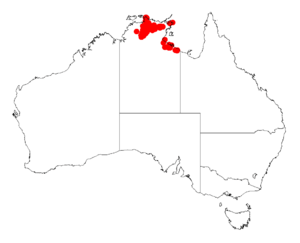Acacia producta facts for kids
Quick facts for kids Acacia producta |
|
|---|---|
| Scientific classification | |
| Genus: |
Acacia
|
| Species: |
producta
|
 |
|
| Occurrence data from AVH | |
Acacia producta is a type of shrub. It belongs to the Acacia family, also known as wattles. This plant is special because it only grows in one area: the northern central part of Australia. When a plant or animal only lives in one specific place, it's called endemic.
What is Acacia producta?
This shrub usually grows to about 2 meters (about 6.5 feet) tall. It can grow straight up or spread out low to the ground. It has smooth, dark grey bark. Its branches are a bit angled and have small, wavy bumps made of resin, which is a sticky sap.
Like most Acacia plants, it doesn't have regular leaves. Instead, it has special flattened stems called phyllodes. These phyllodes are always green. They can be shaped like an oval or a narrow spoon. They are either straight or slightly curved. Each phyllode is about 3 to 8 centimeters long (1 to 3 inches) and 5 to 23 millimeters wide (about 0.2 to 0.9 inches). They also have three clear lines, or nerves, running along them.
How it got its name
The Acacia producta was first officially described in 1980. A botanist named Mary Tindale gave it its scientific name. She wrote about it in a scientific journal called Telopea.
Later, in 2003, another botanist named Leslie Pedley changed its name to Racosperma productum. But then, in 2006, it was changed back to its original name, Acacia producta.
Where it grows
This plant is found in the northern part of the Northern Territory in Australia. This area is often called the "Top End." You can even find it on Maria Island, which is in the Gulf of Carpentaria.
It usually grows on rocky areas made of sandstone. It likes to live on high, flat areas called plateaus or in flat areas near rivers. It grows in sandy, loamy, or sandy-silty soils. Sometimes, it grows over a type of soil called laterite. You can find it in forests where Eucalyptus trees grow or in areas with low, dense shrubs called heathland.

